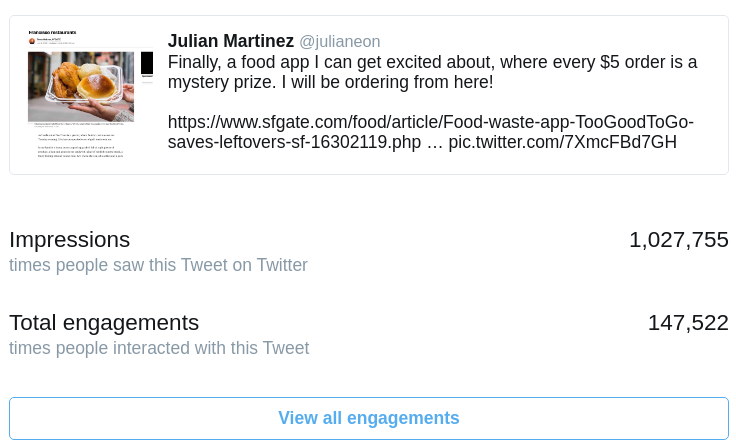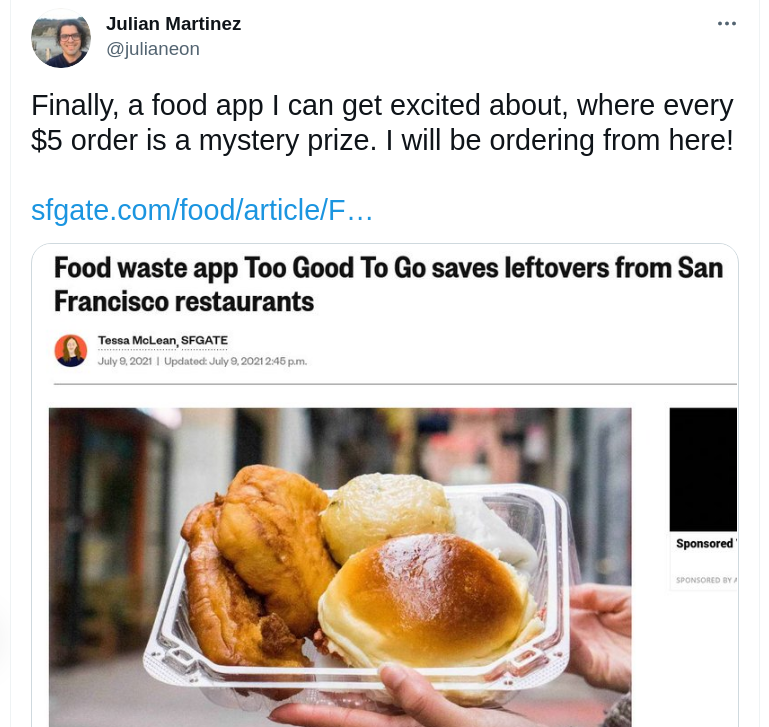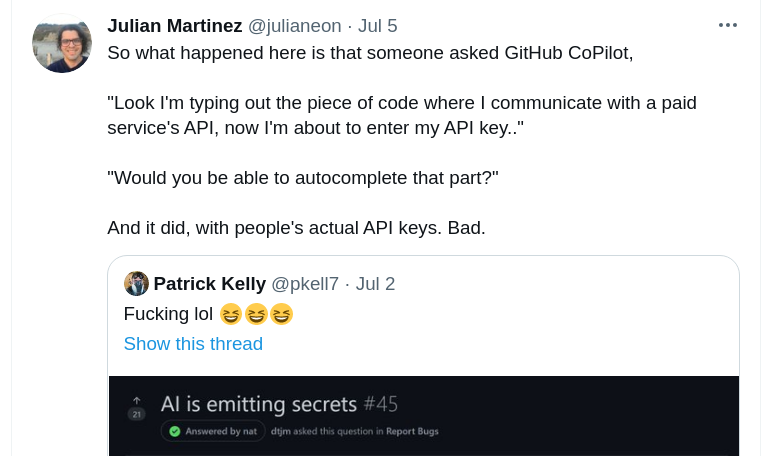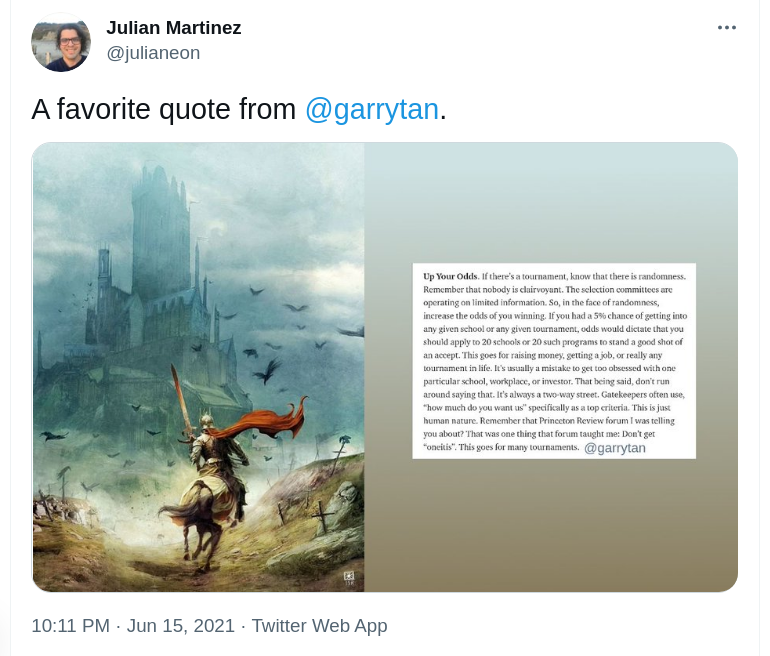
In 2020, there are 3.96 billion people actively using social media in the world, and this is an increase of 10.9% year-on-year from 2.48 billion in 2019.
How to Go Viral on Social Media: My Experience
My Track Record on Social Media
I've been on Twitter, my proxy here for social media, for about 5 years.
I recently had a tweet pass 1 million views.
3 days before that, I had my first tweet exceeding 200k views.
A few weeks before that, I had a much more ordinary tweet do 40k views.
1,000,000: Food App * 200k: GitHub Copilot * 40k: Illustrated Quote
So that makes 3 cases, enough for a small case study, stepping down 5x in popularity each time.
I learned about the possibilities each time, and then stepped up to the next level.
Here's what I learned from each experience.
Case #1: The Food Tweet (1,000,000 views)

How I Improved A News Tweet
I saw a story by SFGate about an app that lets you pay $6 worth of food to get $18 worth of food at participating restaurants.
In the article, the value prop wasn't as clear. They called it 'food waste' (unappealing). I had to read for a while to get the gist.
I retitled it - finally, a food app worth my time! - made the proposition clear - $5 to spin the wheel for a lucky food prize - and included a picture from the article that highlighted the best part - the writer bringing home a big goodie bag worth 3-5x more than they paid.
Then I pressed send, expecting to get less than a dozen likes. Just another tweet, one of many.
How My Tweet Went Viral
Things got off to a slow start. If it hadn't been seen by the right person, I might never have written this article.
The virality happened when SFGate saw the story and retweeted it.
Within a half hour - boom. It seemed like, every time 1 person retweeted it, 2 pepole within that group would do the same.
My mentions blew up. It was basically a nonstop stream of people retweeting, commenting, liking. All I could do was skim them, get a brief sense of what people were saying, then brace for more.
How Blowing Up Affects the Conversation
Over time, the conversation became less about the tweet, and more of a free-associative meditation on everything related to food.
Food sharing. Food waste. Working in restaurants. How you should bring this app to my city too.
The conversation became less about what it literally said, and more about what it said about us, as a society, that it had reached that level of popularity.
At that point, it really feels much bigger than you.
The Growth Pattern of a Viral Tweet
On the first night, maybe 6 hours from posting, it hit 200k. The next morning, it was at 500k. 24 hours after that, it was at a million.
It made me think of a bacterium inside a petri dish. It booms in size, hits the rim of the container, and then plateaus. Because there's nowhere left to grow: everyone who could've been interested in this saw it.
Around one million impressions, growth cratered - just a couple retweets, ever 20 minutes.
I even saw some complaints about 'that food sharing tweet', that people were weary of seeing it all over their timeline. (Sorry!)
This was the viral tweet that hammered home the importance of the retweet.
Case #2: The GitHub Copilot Tweet (200k views)

How I Clarified a Post About AI Writing
When I saw the tweet that inspired this one, I wasn't sure what I was looking at.
The tweet I retweeted said 'AI is emitting secrets.' After reading it and thinking about it for a bit, I realized - this person is asking GitHub Copilot for secrets, and GitHub Copilot is revealing them.
So I wrote that up in a tweet, didn't think much about it. Pressed send.
How A Retweet Changed Everything
The tipping point was a retweet.
The guy who wrote the original tweet retweeted mine (thank you, man).
It seems there was a big audience of people who could now understand the tweet and relate to it, because retweets rocketed upwards.
How Going Moderately Viral Changed the Conversation
It was a lot of people retweeting, and a lot of notifications, but it wasn't completely insane this time. I could read what people were saying and, if I wanted to, I could respond, without being overtaken by a hundred responses.
The conversation seemed more manageable and not all over the place: this time, about whether they were really secrets, and the ethics of GitHub. (I come down on the side of 'they were secrets' but I won't get into that here.)
I was glad to bring attention to the issue, to explain something people found difficult to understand.
Also, I got "paid" in the form of a valuable reward: more followers. The subject was close enough to my public profile that people saw my tweet, read my profile, and decided to follow me.
So count this as a win.
Case #3: The Illustrated Blog Quote (40k views)

Illustrating a Quote
This one was pretty calculated.
I was looking to practice making graphics, and I wanted to find a good blog quote for it.
After doing some hunting around online, I found an essay I liked from Garry Tan, about competition.
So I made the illustration, tweeted it, and tagged him.
Getting the Retweet
It was live for a while, not doing much, when Garry retweeted it.
Other people started to retweet, and the conversation around it was next to nothing: just an image people like.
I tried doing other images, but none of them took off like this one did; in retrospect none of the others got a significant account retweet, either.
Getting retweeted makes all the difference.
Lessons Learned
Looking at these 3 cases of a viral tweet, you can find some commonalities.
Find Something Retweetable
Target things that could be retweeted to a wide audience.
I don't think any of these 3 would have made this list, if an account with a lot of followers had not retweeted them.
Do the Work to Make It Better
There's a decent amount of work anyone can do, to be helpful and achieve retweets.
Look at complicated things online and boil them down to something simpler, so people can understand them more easily and at a glance.
Or, make them better looking. That's an option too.
Update your Mental Model
One way to think of Twitter - let's call it the naive way - is that it's like a house party, where everyone is in a room, chatting.
If someone says something, you talk back. Everyone's on a roughly equal footing.
Another way that these tweets inspired me to take up, however, is to think of Twitter as a game of virality.
You have your building blocks: other people's tweets or articles, or the material from your own life.
You try to string them together in a way that other people would find appealing. Then, take your shot.
If you took a good one, as judged by the algorithm, your 'score' will reflect that.
I'm not saying this mental model is literally true (opinions are worth more than likes).
I am saying it's helpful to view Twitter through this lens, at times, to understand how the system works, and how you can game it.
Playing the Lottery
Finding A Good Lottery to Play
A thing I think about sometimes is: what's a good lottery that I can play?
I don't mean a lottery where the odds of winning are one in a hundred million (aka the actual state-sponsored lottery).
Going for a big social media success is a good lottery. Unlike those other lotteries, it's worth playing.
You Only Need One Megahit
Think of it this way.
All you really need is one big win to justify the effort, to 'retire.'
Because, on the basis of one viral tweet describing your business, you could generate enough attention, and traction, to be set for life.
Realistically, I know that's only the first step. But it's the first one, and the one that unblocks all the others.
Playing The Lottery Often
You have an almost infinite number of at bats: you can go in at any time and take one, attempt to make a business-generating post.
I can't say I've done that myself. But I can try, and given a long enough time span, I think it could work.
It is a lottery - but one where the odds are great more in your favor.
Whole business have already been built off social media smash hits, as described in this Business Insider article.
So why not go for it? If you win, you could have a multimillion dollar business right there.
And if you don't have one - yet - keep trying.